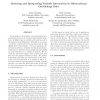Free Online Productivity Tools
i2Speak
i2Symbol
i2OCR
iTex2Img
iWeb2Print
iWeb2Shot
i2Type
iPdf2Split
iPdf2Merge
i2Bopomofo
i2Arabic
i2Style
i2Image
i2PDF
iLatex2Rtf
Sci2ools
ICDM
2009
IEEE
2009
IEEE
Detecting and Interpreting Variable Interactions in Observational Ornithology Data
In this paper we demonstrate a practical approach to interaction detection on real data describing the abundance of different species of birds in the prairies east of the southern Rocky Mountains. This data is very noisy - predictive models built from this data perform only slightly better than baseline. Previous approaches for interaction detection, including recently proposed algorithm based on Additive Groves, might not work ideally on such noisy data for a number of reasons. We describe the issues that appear when working with such data sets and suggest solutions to them. We further demonstrate that with our improvements to the interaction detection algorithm it is possible to detect interactions between important features and the response function, even when the data is this noisy. In the end, we show and interpret the results of our analysis for several bird species.
| Added | 23 May 2010 |
| Updated | 23 May 2010 |
| Type | Conference |
| Year | 2009 |
| Where | ICDM |
| Authors | Daria Sorokina, Rich Caruana, Mirek Riedewald, Wesley M. Hochachka, Steve Kelling |
Comments (0)

